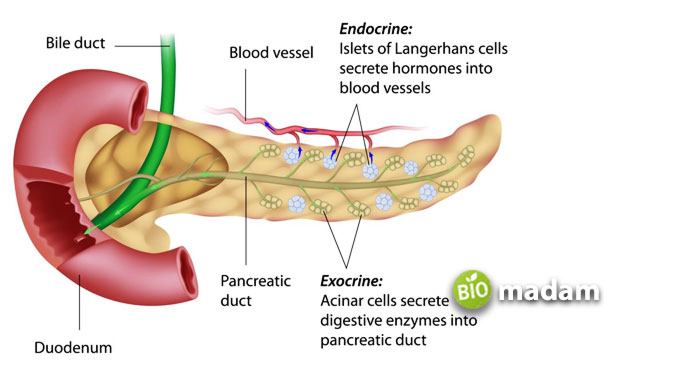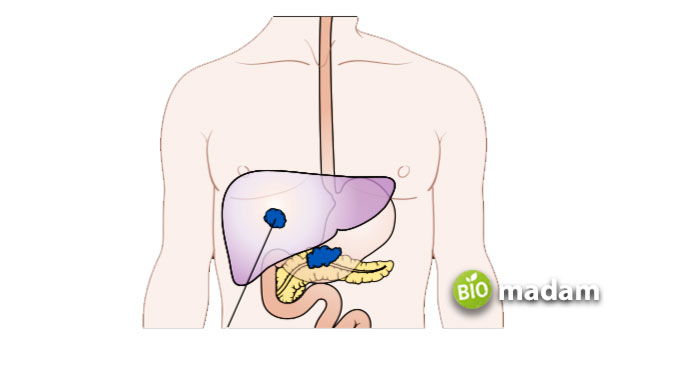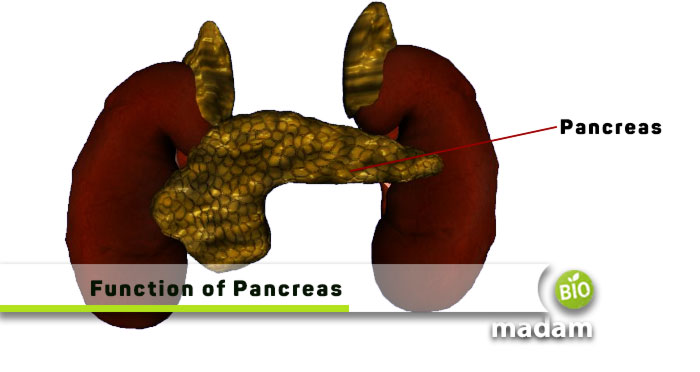The human body consists of a channel of different systems that work together to make the entire body function properly. These are the respiratory system, including right and left lungs; the circulatory system, including blood and plasma; the skeletal system, including bones; and the digestive system, comprising several organs, like the stomach, small and large intestines, and pancreas.
The pancreas is also called the heterocrine gland, which means it works as an endocrine and exocrine gland. This almost six inches long organ is located in the abdominal cavity. In human anatomy, it is observed that other digestive organs surround the pancreas. Let’s move further to comprehend more about its anatomy, physiology, and pathophysiology.
What is a Pancreas?
It is a flat, pear-shaped structure surrounded by the stomach, intestines, spleen, gallbladder, and liver. Pancreas has a vital role in digestion and regulates blood sugar levels. In other words, almost 95 per cent contribution of the pancreas is in the digestive system, whereas the remaining 5 per cent or less is related to hormones.
Parts of Pancreas
If you observe this organ, it will look like a small sweet potato. As we’ve discussed, almost 95% of the pancreas helps in digestive functions; it does so through the exocrine tissues. The remaining 5% consists of cells called islets of Langerhans, responsible for performing hormonal functions. A pancreas is divided into the following portions: head, neck, tubular body, and tail. It is horizontally extended towards the abdomen.
Head: It is the widest part of the pancreas, located close to the center of the abdomen. In other words, the head portion of the pancreas lies where the stomach connects to the small intestine.
Neck and Body: The pancreatic neck is a connection point between the head and body of the pancreas, which is about 2.5 cm long. It is present where the portal vein is formed. This neck part typically releases different digestive enzymes for the absorption of food.
Tail: Then comes the tail part of the organ. It is observed to be a thin tip present anterior to the left kidney. A pancreatic tail is involved in both functions, secreting enzymes to help digestion and regulate hormones.
All these organ parts are supplied blood through major blood vessels, including the superior mesenteric vein, superior mesenteric artery, and portal vein.

The Function of the Pancreas
The food we digest daily is through the combined effort of the working of the stomach, small and large intestines, and pancreas. A healthy pancreas performs its significant functions by secreting various enzymes and hormones.
Let’s discuss the organ functions as an exocrine and endocrine gland in detail below:
Exocrine Function for Digestion
A pancreas functions to produce natural juices called pancreatic enzymes, such as lipase, amylase, and protease. These enzymes work together to break down the food particles from the stomach to the duodenum part of the small intestine. Proteases, such as trypsin and chymotrypsin, are specified to digest essential proteins from food. Similarly, amylase works to digest carbs from the total calories, and lipase breaks down fats, oils, and triglycerides. According to a study, your pancreas makes up almost eight ounces of juice filled with enzymes each day.
The pancreas releases its juice into the central pancreatic duct once the food enters the stomach. This small duct then joins the common bile duct to create the main ampulla of Vater, which is present in the duodenal part of the stomach. The common bile duct, an essential element for secreting enzymes, originates from the gallbladder and liver to produce another digestive juice called bile. The ampulla of Vater serves as a reservoir for these pancreatic juices and bile that work together to aid in the entire digestive process.
Endocrine Function to Regulate Blood Sugar Level
Unlike exocrine glands, the endocrine releases hormones to be sent directly to the bloodstream. Pancreas has a similar role. There are clusters of cells within the organ called the islets of Langerhans that are responsible for these endocrine functions. These clusters are mainly of two types: alpha cells and beta cells. It is commonly assumed that alpha cells comprise almost 20% of the pancreatic endocrine system, while beta cells vary between 50 to 70 per cent. Both have an antagonistic effect as alpha cells secrete glucagon to increase blood glucose. On the other hand, beta cells release insulin to adjust or lower the glucose levels in the blood.
Overall, the endocrine functions of the pancreas are essential for maintaining the glucose levels in the human body. Dysfunction of this organ may lead to acute or chronic conditions, like hypoglycemia or hyperglycemia. This sudden decrease or increase in blood sugar levels can cause multiple health problems, including kidney failure and heart disease.
Health Conditions Associated with Pancreas
Sometimes, the pancreas fails to produce sufficient digestion enzymes, leading to less food absorption. It can result in severe diarrhea, nausea, or weight loss. Similarly, pathological changes in the pancreas can result in different diseases or disorders, which are explained below:

Diabetes
When a human body cannot produce enough insulin through islets of Langerhans, it increases blood sugar levels. A constant or persistently high glucose level ultimately results in diabetes that is either type 1 or type 2. Diabetes, contrary to hypoglycemia, has a direct effect on what happens after digestion. For example, if you consume food enriched with carbs despite being diabetic, you may experience a high glucose level. Diabetic patients need proper treatment, including oral medication and direct insulin through subcutaneous injection.
Pancreatic Cancer
There could be multiple causes of pancreatic cancer, such as smoking, chronic pancreatitis, diabetes, etc. It develops when the organ’s cells grow abnormally, forming a cyst or tumor. This initial benign cancer can convert to malignant if not treated properly and promptly. However, pancreatic cancers are often not detected in the early stages. But if diagnosed, one should immediately go for chemotherapies, radiotherapies, or surgery.
Pancreatitis
Inflammation of the pancreas leads to a condition called pancreatitis that can be acute or chronic. Acute pancreatitis is a sudden inflammation of the pancreas, often caused by gallstones or heavy alcohol use, and can be a medical emergency. Chronic pancreatitis, on the other hand, is a long-term inflammation of the pancreas that can lead to permanent damage and loss of function. The digestive enzymes, in this condition, become prematurely active and start digesting the pancreas itself. It brings out severe abdominal pain, tissue damage, and inflammation of the surrounding areas. The treatment always depends on the severity of the condition, including pain management, hospitalization, or surgical removal of damaged tissue.
Bottom Line
In conclusion, the pancreas is one of the essential organs that also works as an endocrine gland. It is a vital organ to play its part in digestion, besides other organs. Moreover, managing the daily blood sugar levels requires the proper functioning of the pancreas. You can consult a physician for a regular checkup if you feel symptoms related to improper pancreatic working or indigestion, such as loss of appetite, weight loss, abdominal pain, etc.
FAQs
Which fruit is good for the pancreas?
There are several natural ways to protect your pancreas or keep it strong. Fruits like red grapes and apples are best to consume to maintain organ health. These contain resveratrol or antioxidants that help the organ fight against inflammation.
Can a person live without a pancreas?
Yes, it is possible to live without a pancreas; however, the removal might cause difficulty in living. As the pancreas helps produce insulin to maintain blood sugar levels, its removal can develop diabetes. Diabetic patients cannot control their glucose levels due to lacking insulin hormones.
Can the pancreas heal like a liver?
The liver naturally has the ability to regenerate itself, and just like that, the pancreas also has a sufficient capacity to restore the damaged part after an injury or inflammation. A pattern, including activation and proliferation of stellate cells, involvement of extracellular matrix, and activation of acinar cells, characterize the normal regeneration of the organ from acute pancreatitis.
What foods are bad for the pancreas?
A few things should be avoided when you have pancreatic health issues. These include alcohol consumption, fried items, food enriched with fats, fast food, etc. Such food items can trigger the digestive enzymes leading to overactivity of the pancreas, despite that it’s lacking good condition.
Does pancreatitis cause gas?
Gas is quite a common symptom in the inflammation of the pancreas. However, flatulence resulting from constant gas is not a direct symptom. It indicates that your pancreas is heading towards swelling or inflammation.

Jeannie has achieved her Master’s degree in science and technology and is further pursuing a Ph.D. She desires to provide you the validated knowledge about science, technology, and the environment through writing articles.

